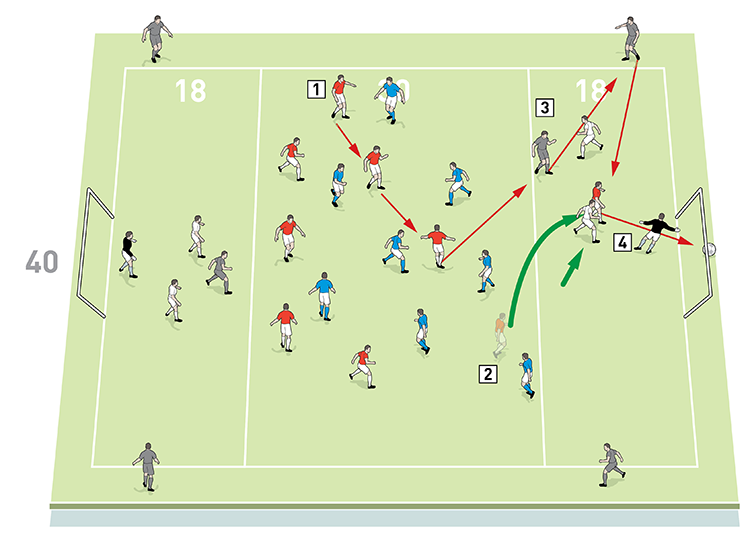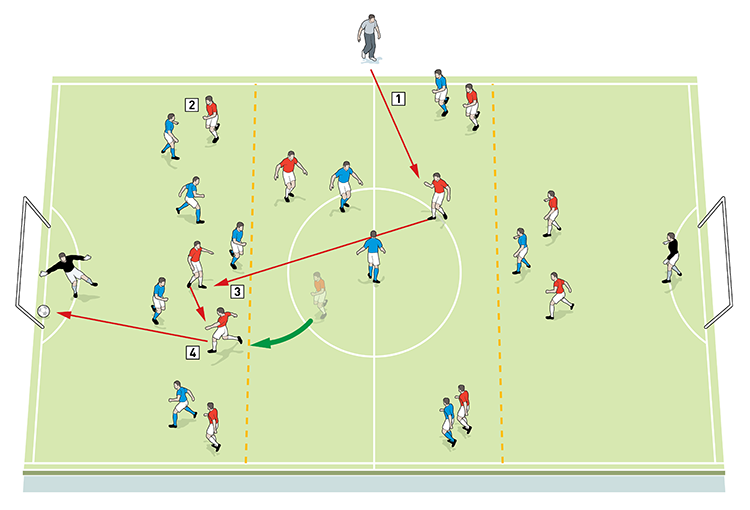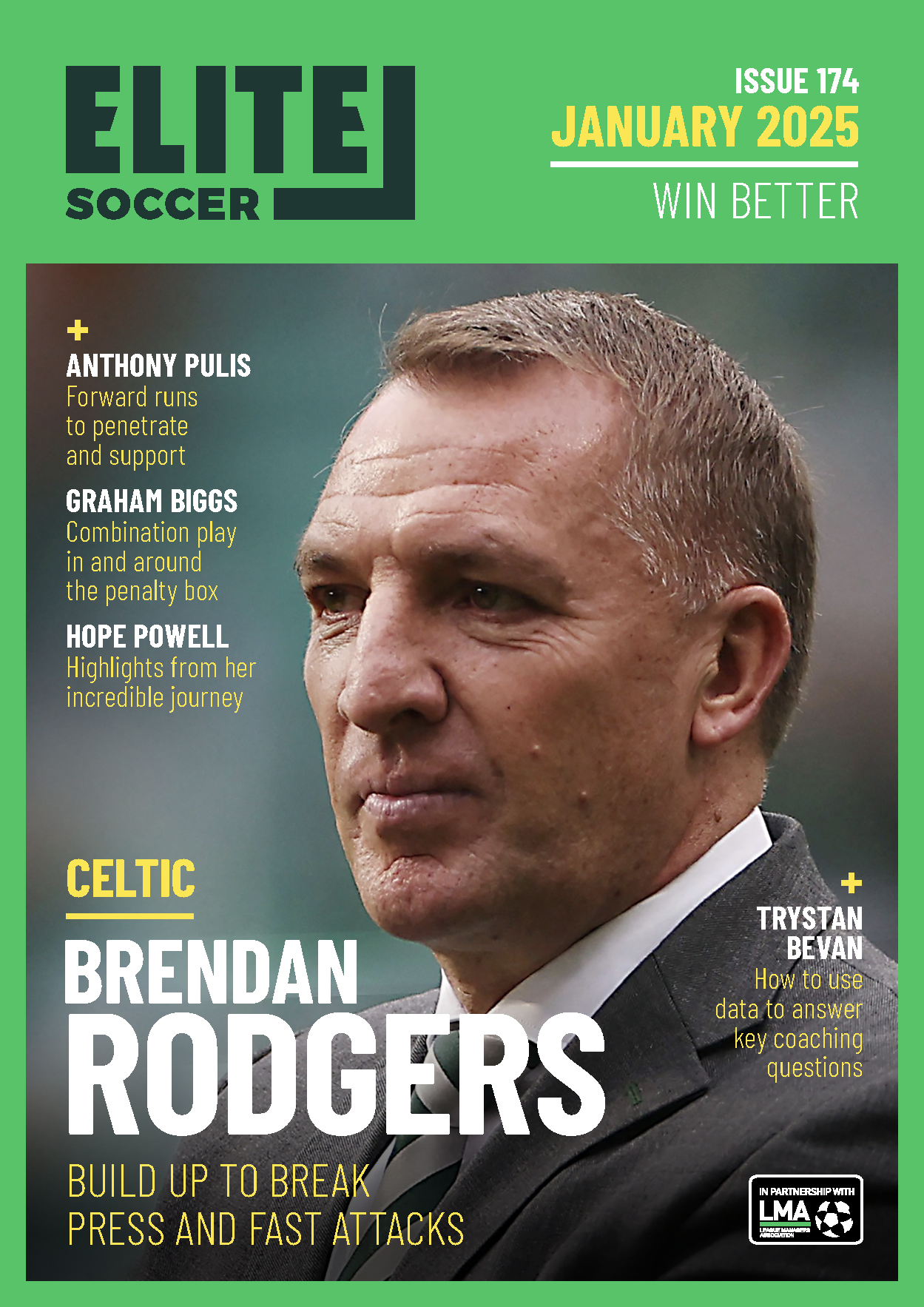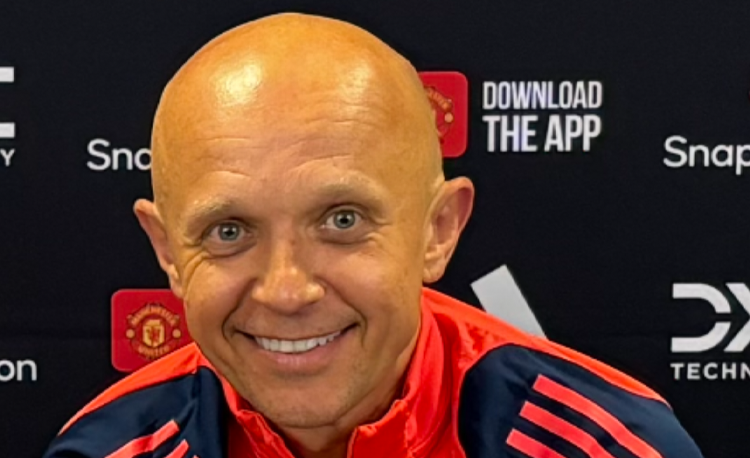You are viewing 1 of your 1 free articles
Encouraging forward runs from midfield
Use possession practices, small-sided games and finishing drills to highlight and encourage players to run from midfield into advanced areas.
| Area | Use of a full pitch |
| Equipment | Balls, cones, goals |
| No. of Players | Up to 11v11 |
| Session Time | 90mins |
This session is designed to highlight and encourage players to run from midfield into advanced areas.
The process and logical steps the session undertakes are motivating in themselves, with possession practices, small-sided games and finishing all common favourites in every dressing room. However, the hidden principles contained here for coaches are the technical, tactical and, most importantly, physical aspects that are there to be implemented.
I am not an advocate of non-directional possession so I like to run this as often as possible, as there is a defined link between development and production on a match day. And each time we play this out I will add layers, though with a constant awareness of the physical demands of the session and the reality that players must have time to recover before match day.
What do I get the players to do?
8v8 practice
After an initial warm-up, we will go into the practice to ensure players are physically and mentally ready for the session. The first set-up takes the form of an 8v8 central practice (and 20 players in total) in a 40x40-yard area, as shown (1).
1

2. They use the forward in completing four passes
3. The ball is played right to the target man and a point is scored
We use forwards on top and bottom sides to create overloads – these are two-touch maximum, and the team in possession must complete four passes within their team before they score by feeding either target man.
What are the key things to look out for?
We want team members to play what they see early, creating quick angles around the ball. Playing into the target player as quickly as possible once four passes are completed is essential. These passes engage players, not only on retention but also in dragging the opposition towards the ball.
Once four passes have been completed (or in game situations, the opposition have been ‘dragged in’), we must see players working off the target (or our centre-forward) to execute the space created. This lays the foundations by creating our passage through the attacking area and, ultimately, the space that leads our midfield players into making forward runs.
8v8 practice plus goals
To extend the initial practice we now make the main area a 40x30-yard space, but add on an 18-yard box at each left and right side, as shown (2). The conditions remain the same, with four passes required before a ball is played off either target man.
2

2. One of the overloading forwards is used as a diversion with the ball played back inside
3. Quick passing sets the target player through on goal
4. He finishes well past the keeper
This now moves the attack into an attempt at goal, with the 10v8 overload leading to a situation where any player from the team in possession can break out of the main area to finish one-touch (unopposed) against the keeper. If the player scores, his team retains the ball; if he fails to find the net the game restarts with the other team in possession.
How do I progress the practice?
As an initial progression, we will use the same practice and organisation, but give each team an end to defend and attack, making each target player a designated centre-forward for each team.
What are the key things to look out for?
We want to see in players a recognition of when and where to play into the target man. We’re also looking to isolate the timing and angle of the run when one solitary attacker breaks out of the main area. With this in mind, players need to think about who, when and how they break out, and it’s important that the quality of finish is there to enable the team to retain possession and not, in a match situation, be counter-attacked.
This extension to the main session, and its subsequent coaching points, makes the practice more realistic before we go into the game scenarios, mostly because we are now using the target man as a designated centre-forward. We could even add in a second target man if it’s our intention to operate with two position-specific centre-forwards.
In terms of further progressions, we can add in a tracking defender to develop player runs off the target man, with the aim of looking at timing, disguise, angle and intent, with the player really wanting to break that line. He can now finish on any number of touches as he is pursued by a defender.
We can also add a defender in each final third to make 1v1s and 2v2s in that area, can increase player numbers entering the final third (and have them tracked or untracked), and can even add forwards higher up the pitch in order to change the point of the attack (for example, from crosses, as shown (3). In this instance, we might allow four passes to play off the target or allow the forward to cross, with midfield runners now joining off crosses as well.
3

2. The attacking red moves into the box
3. The forward is now acting as a winger
4. A precise cross is well finished past the keeper
9v9 to 11v11
Now we will observe the topic in a game – in the example shown (4) it’s a 10v10. There are no conditions, just the principles highlighted in the previous practices.
4

2. Attackers successfully drag defenders away from the ball
3. The pass is played into the centre-forward
4. Supporting players join and a goal is scored
I like to start the game in the middle third in order to highlight ‘dragging’ the opposition in to then play off the centre-forward and join.
What are the key things to look out for?
As a coach, it’s all about applying your system, principles and strategy to the tactical work, and in the event the focus of the practice is lost, I will intervene and condition appropriately.
In conclusion, running from midfield is more an attitude than a tactic or strategy, and players have to want to get beyond the opposition, knowing they might only receive from one in five runs. However, the rewards for the individual and the team, when executed correctly, are massive.
Related Files
Editor's Picks
Using the goalkeeper in build-up play
Pressing principles
Intensive boxes drill with goals
Penetrating the final third
Creating and finishing
My philosophy
Pressing initiation
Compact team movement
Defensive organisation
Coaches' Testimonials

Alan Pardew

Arsène Wenger

Brendan Rodgers

Carlos Carvalhal

José Mourinho

Jürgen Klopp

Pep Guardiola

Roy Hodgson

Sir Alex Ferguson

Steven Gerrard
Coaches' Testimonials

Gerald Kearney, Downtown Las Vegas Soccer Club

Paul Butler, Florida, USA

Rick Shields, Springboro, USA

Tony Green, Pierrefonds Titans, Quebec, Canada
Join the world's leading coaches and managers and discover for yourself one of the best kept secrets in coaching. No other training tool on the planet is written or read by the calibre of names you’ll find in Elite Soccer.
In a recent survey 92% of subscribers said Elite Soccer makes them more confident, 89% said it makes them a more effective coach and 91% said it makes them more inspired.
Get Monthly Inspiration
All the latest techniques and approaches
Since 2010 Elite Soccer has given subscribers exclusive insight into the training ground practices of the world’s best coaches. Published in partnership with the League Managers Association we have unparalleled access to the leading lights in the English leagues, as well as a host of international managers.
Elite Soccer exclusively features sessions written by the coaches themselves. There are no observed sessions and no sessions “in the style of”, just first-hand advice delivered direct to you from the coach.









